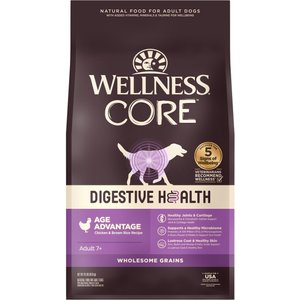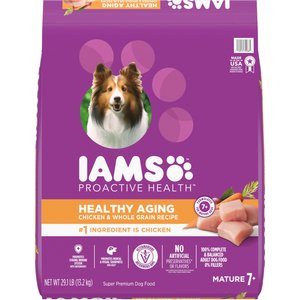Selecting the best senior dog food requires knowing what your individual pet needs. Though things like teeth, joint health and weight are often the first things that come to mind when thinking of food for a senior dog (and rightfully so!) there’s something that often goes overlooked: Maintaining lean muscle mass. As with people, sarcopenia—the loss of muscle mass that accompanies aging—is also a concern for dogs. For healthy senior dogs who don’t have a medical reason for needing a low protein diet, protein intake is a priority.
Though dietary protein alone won’t help any of us maintain all the muscle mass of youth, it is an important component. With protein in mind, I’ve rounded up my choices for the best senior dog food from some of the best dog food brands. Please discuss your pet’s individual needs with your veterinarian before making any changes.
How to choose the best senior dog food
Talk with your veterinarian
This is an absolute first step. One senior dog’s dietary needs may be significantly different than the next. Factors that need to be evaluated before selecting a food include—but are not limited to—lab results (such as kidney and liver function), body condition score, muscle condition score, dental health (can my dog comfortably chew dry food?), fiber content (does my dog need less fiber to increase the digestibility of their food?), sodium content (does my dog have a heart condition?), and fat content, to name a few.
Your veterinarian may also choose to formulate a diet specifically for your senior pet. They may partner with a nutrition service, such as Balance It (which is recommended for healthy pets by Cornell College of Veterinary Medicine), or they may refer you to a specialty veterinarian who is board certified in nutrition.
Ingredients
Look for foods where the protein is primarily from animals. Dr. Joseph J. Wakshlag, DVM, PhD, DACVN, DACVSMR, the Chief of Nutrition at Cornell University’s College of Veterinary Medicine says that for senior dogs, animal protein sources may be better than plant protein because animal protein has a better amino acid profile for dogs. Animal protein is also more digestible than higher fiber-containing plant proteins, which becomes important as a dog ages. In general, dietary fiber decreases a dog’s ability to digest and absorb certain amino acids.
Dietary fat is another factor when selecting a food. As dogs age, the propensity for body fat increases. Dogs who are overweight and/or have decreased activity levels may need to be switched to foods with reduced fat.
Dry versus soft/wet food
An upside of dry food is that dogs may accumulate tartar more slowly compared to wet food. A downside is that dogs with dental pain or not enough teeth to comfortably chew kibble, may gulp down unchewed kibble. Food is meant to be chewed.
Wet food is great for dogs who have dental issues, such as no teeth or just a few teeth left. Wet food also has significantly more moisture content, which can help with hydration. Whether or not a senior dog needs wet food, a combination of wet and dry, or dry food with or without added water, should be determined on a case by case basis.
Keep in mind that when evaluating the percent of protein, fat and fiber on a label for wet food, because of the moisture content, these ‘as fed’ values don’t directly correlate to the values on dry dog food labels. There are calculators online to help determine what the percentages translate to on a dry matter basis. ‘Dry matter basis’ is the percentage of nutrients in a food when all moisture has been removed. But to complicate things further, dry food is not void of all moisture. It contains up to 14%. For fresh pet food products, some of them have both the ‘as fed’ values and the ‘dry matter basis’ values on their website but some do not. A simple way to compare wet food to dry is calories per cup, however that won’t be enough information if your pet’s protein, fat and/or fiber intake need to be between specific values due to medical reasons. Your veterinarian can serve as a resource in sifting through pet food labels.
Senior food versus adult maintenance versus all life stages
Due to various biological factors as dogs age, their muscle mass decreases. Dr. Wakshlag says, “We may not necessarily see it because the dog remains the same weight” due to the amount of body fat increasing. He says that veterinarians often focus on Body Condition Score (BCS) but don't assess Muscle Condition Score (MCS.) Even though dietary protein alone isn’t enough to maintain lean muscle mass in an aging pet, it is an important component.
Since senior dog foods (which are labeled for dogs older than 7) vary widely in their nutritional composition—particularly in the area of protein—they may or may not be suitable for your pet. For example, Blue Buffalo Life Protection Formula Senior Chicken & Brown Rice has 18% crude protein (min.) whereas Blue Buffalo Wilderness Senior High Protein—that I featured in this article—contains 30% (min.) Breed also needs to be taken into consideration. A small breed dog isn’t a senior until 8 to 10 years of age but a large breed is a senior at age 7, and a giant breed at age 5.
For some dogs—based on their physical exam, lab work, breed and physical activity levels—an adult food (labeled for dogs between 1 and 7 years old), or an all life stages food (for dogs of any age), may be more appropriate. Your veterinarian, or a board certified veterinary nutrition specialist, is your best resource on which food best suits your pet’s needs.
Our top picks for the best senior dog foods

Nom Nom Turkey Fare
Nom Nom is a newer dog food company, founded in 2014, that offers four, gently cooked recipes for dogs. Their All Life Stages diets were formulated by board-certified veterinarians specialized in nutrition and are sold frozen, either as a subscription or through PetSmart. One of the reasons I like this food is because it doesn’t contain peas, chickpeas, lentils or dry beans. These ingredients—also known as pulses—are being further researched, as they’ve been linked to some cases of canine diet-associated dilated cardiomyopathy (DCM), a type of heart disease. It also doesn’t contain potatoes or sweet potatoes, which are a lesser concern than pulses but are also being evaluated to see if they play a role.
Specifications
- First five ingredients: Turkey, brown rice, eggs, carrots, spinach
- Flavors: Beef Mash, Chicken Cuisine, Pork Potluck, Turkey Fare
- Estimated calories: 168 kcal per cup
- Crude protein (min): 10%
- Crude fat (min): 5%
- Crude fiber (max.): 1%
- Packaging size: Sizes are customized for each pet
- Price at publish: Price varies by each custom order but estimates are available
Pros:
- First ingredient is turkey
- Contains fish oil, which is a source of joint-supporting omega-3 fatty acids
- Contains carrots, which is a good source of nutrients like vitamin C and beta carotene
- No corn, wheat or soy
- Can be tailored for needs like weight loss or weight gain
Cons:
- Not suitable for dogs allergic to turkey
- May be too much protein or fat for some dogs
The bottom line:
This veterinarian-formulated food is one of the best wet dog foods, and it can be fed as a meal or used as a topper.

Blue Buffalo Wilderness High Protein Senior
Not all of Blue Buffalo’s senior dog foods have enough protein for a generally healthy senior dog, but this one does. It also avoids the potentially problematic pulses (peas, lentils, chickpeas and dry beans), instead featuring ingredients like chicken, oatmeal and brown rice.
Specifications
- First five ingredients: Deboned chicken, chicken meal, dried chicken, oatmeal, barley
- Flavors: Chicken, Beef (but this one also contains chicken)
- Estimated calories: 390 kcal per cup
- Crude protein (min): 30%
- Crude fat (min): 12%
- Crude fiber (max.): 7%
- Packaging size: 13, 24 and 28 pound bags
- Price at publish: $47 per 13-lb. bag, $67 per 24-lb. bag, $80 per 28-lb. bag
Pros:
- First ingredient is chicken
- Reduced fat
- Contains glucosamine and chondroitin
- no need to have more than one bullet about omega-3s
- Contains eicosapentaenoic acid (EPA) and docosahexaenoic acid (DHA)—types of omega-3s—whose various benefits include supporting the immune system, joint health and reducing inflammation
- No peas, lentils, chickpeas or dry beans
- No corn, wheat or soy
Cons:
- Not suitable for dogs allergic to chicken
- Contains potatoes
The bottom line:
This senior diet has a nice combination of reduced fat, 30% protein, and nutrients to support skin, coat and joint health.

Wellness CORE Small Breed Digestive Health Chicken & Brown Rice
The interesting thing about a lot of senior dog foods is they tend to be low in fat (that’s good) but also low in protein, e.g. 18 to 23% for dry food (not so good.) As I mentioned, I like a senior dog food that’s higher in protein, preferably 30 to 32%, which is the recommendation from Dr. Wakshlag for a generally healthy senior dog.
Many ‘All Life Stages’ premium dry foods (e.g. Earthborn, Zignature, Solid Gold,) hit this ideal protein amount. But for a senior, the fat content in these is often on the high end of the spectrum (17 to 18%.) That is, except in this Wellness CORE ‘All Life Stages’ food, an adult (i.e. not senior) small breed food that is surprisingly what I want. This food also contains nutrients for gut, skin/coat and joint health.
Specifications
- First five ingredients: Deboned chicken, chicken meal, turkey meal, brown rice, oat groats
- Flavors: Chicken & Brown Rice
- Estimated calories: 424 kcal per cup
- Crude protein (min): 34%
- Crude fat (min): 14%
- Crude fiber (max.): 4%
- Packaging size: 4 and 12 pound bags
- Price at publish: $19 per 4-lb. bag, $38 per 12-lb. bag
Pros:
- Contains omega-3 and omega-6 fatty acids
- Contains antioxidants like vitamin A and E
- Contains glucosamine and chondroitin
- Contains prebiotic fiber for gut health
- Doesn’t contain peas, lentils, chickpeas or dry beans
- No corn, wheat or soy
- Contains 10 strains of probiotics. (Read more about how the viability of these might be diminished, or gone, by the time your dog eats them, in the best dog food for sensitive stomachs.)
Cons:
- Only comes in one flavor
- Not suitable for dogs allergic to chicken or turkey
- Will be too many calories for some senior dogs
The bottom line:
With its moderate fat, high protein, and nutrients for joint and gut health, this adult maintenance diet for small doggos can be suitable for some healthy seniors.

Blue Buffalo Wilderness Large Breed Healthy Weight with Chicken
Due to the low protein content of some senior dog foods, Dr. Wakshlag says that he doesn’t always recommend a senior diet. Blue Buffalo Wilderness Large Breed is an adult maintenance diet with a good amount of protein (28%,) low fat content (9 to 12%,) and joint support from glucosamine, chondroitin and omega-3 fatty acids. With your veterinarian’s guidance, they can help you determine if this is suitable for your healthy, large breed senior dog. However, depending on your large breed dog’s needs, the amount of joint support may not be enough. You should talk with your veterinarian about whether additional supplementation with a joint health product is needed.
Specifications
- First five ingredients: Deboned chicken, chicken meal, dried chicken, oatmeal, barley
- Flavors: Chicken
- Estimated calories: 347 kcal per cup
- Crude protein (min): 28%
- Crude fat (min): 9%
- Crude fat (max): 12% (most foods don’t list a max but this one does.)
- Crude fiber (max.): 10%
- Packaging size: 28 pound bag
- Price at publish: $86
Pros:
- Meat is the first ingredient
- Contains prebiotic fiber for gut health
- Contains glucosamine
- Contains omega-3 and omega-6 fatty acids
- Doesn’t contain corn, wheat or soy
- Doesn’t contain peas, lentils, chickpeas or dry beans
Cons:
- The 10% crude fiber (max.) might be too much for some senior dogs.
- The Large Breed formula only comes in Chicken
- Contains potatoes
The bottom line:
If your large breed senior dog needs to be on a low-fat food, this chicken-based, adult maintenance diet with joint support might be suitable.

Ollie Chicken Dish With Carrots
This easy to digest, All Life Stages, human-grade food is great for senior dogs with a sensitive stomach but who aren’t allergic to chicken. It’s minimally processed and contains nutrient packed produce, such as carrots, spinach and cranberries.
Specifications
- First five ingredients: Chicken, rice, carrots, chicken liver, peas
- Flavors: Chicken, beef, turkey, lamb, pork
- Estimated calories: n/a
- Crude protein (min): 8%
- Crude fat (min): 3%
- Crude fiber (max.): 2%
- Packaging Size: Varies by custom meal size
- Price at publish: Varies by custom meal size and plan
Pros:
- Meat is the first ingredient
- Veterinarian-formulated
- Doesn’t contain chickpeas, lentils or dry beans
- Contains salmon oil, which is a source of joint-supporting omega-3 fatty acids
- Contains produce like carrots which are a source of antioxidants
- Made in human-grade facilities
- Can be stored frozen for up to six months
Cons:
- Not suitable for dogs allergic to chicken
- Contains peas and potatoes
- As a subscription, it may not suit everyone
The bottom line:
If your senior dog doesn’t have a poultry allergy and your veterinarian has determined that peas and potatoes are okay for your pet, this food is one to consider.

Solid Gold Fit & Fabulous Weight Control with Alaskan Pollack
This All Life Stages diet is low-calorie for the senior dog who might be less active or needs to lose weight. With an array of nutrients coming from ingredients like Alaskan pollock, carrots, blueberries and salmon oil, this food might appeal to the seafood loving dog.
Specifications
- First five ingredients: Pollock, pollock meal, pea fiber, pearled barley, brown rice
- Flavors: Alaskan Pollock or Chicken & Sweet Potato
- Estimated calories: 330 kcal per cup
- Crude protein (min): 26%
- Crude fat (min): 6.5%
- Crude fat (max): 9.5%
- Crude fiber (max.): 10%
- Packaging size: 4 and 24 pound bag
- Price at publish: $22 per 4-lb. bag, $73 per 24-lb. bag
Pros:
- Wild caught Alaskan pollock is the first ingredient
- Contains omega-3 and omega-6 fatty acids
- Contains docosahexaenoic acid (DHA,) which has health benefits, like reducing inflammation
- Contains prebiotic fiber for gut health
- Contains one strain of probiotic bacteria
- No corn, wheat or soy
Cons:
- The 10% fiber might be too much for some senior dogs
- Contains peas
The bottom line:
This low-calorie, fiber-rich food is for All Life Stages and helps support skin, coat, gut and joint health.

Earthborn Holistic Venture Limited Ingredient Duck Meal & Pumpkin
This low-calorie, adult maintenance food has a nutritional profile which can be suitable for generally healthy senior dogs. It may also be a good pick if your aging pet requires a limited-ingredient dog food for allergies. But your veterinarian should ultimately determine if a diet like this is suitable.
Specifications
- First five ingredients: Duck meal, pumpkin, tapioca, sunflower oil, flaxseed
- Flavors: Duck, Alaskan pollock, rabbit, lamb, turkey and boar
- Estimated calories: 335 kcal per cup
- Crude protein (min): 27%
- Crude fat (min): 13%
- Crude fiber (max.): 6.5%
- Packaging size: 4, 12.5 and 25 pound bags
- Price at publish: $21 per 4-lb. bag, $61 per 12.5-lb. bag, $85 per 25-lb. bag
Pros:
- One protein source, which can be helpful for dogs with food allergies
- Contains three strains of probiotic bacteria
- Contains omega-3 and omega-6 fatty acids
- Contains prebiotic fiber for gut health
- Doesn’t contain peas, lentils, chickpeas or dry beans
- No corn, wheat or soy
Cons:
- A meat meal is the first ingredient
- The price point may be inaccessible for some pet owners
The bottom line:
This limited ingredient diet has the benefit of containing a single protein source, it’s chicken-free and pulse-free, and it’s lower in fat (crude fat minimum is 13%,) which is ideal for older dogs who are less active.

Wellness CORE Digestive Health Age Advantage Chicken & Brown Rice
This low-fat diet contains nutrients such as glucosamine, chondroitin and long-chain omega-3 fatty acids (such as EPA) to support joint health. It’s more ideal for less active senior dogs or seniors who are overweight. For dogs who are still fairly active, another alternative—with the same amount of EPA as Hill’s prescription j/d diet for joint health—is Zignature Select Cuts Trout & Salmon. This was also my overall top pick for the Best Dog Food for Sensitive Stomach. This Zignature diet, however, contains 14.5% fat (min.), which is a bit much for an arthritic dog who needs to lose weight. Granted, EPA alone isn’t the reason to pick a food, it’s worth considering. Blue Buffalo True Solutions Jolly Joints is another overall good option but it has 15% fat.
Specifications
- First five ingredients: Deboned chicken, chicken meal, brown rice, barley, pea protein
- Flavors: Chicken & Brown Rice, Whitefish & Brown Rice
- Estimated calories: 357 kcal per cup
- Crude protein (min): 28%
- Crude fat (min): 10.5%
- Crude fiber (max.): 4%
- Packaging size: 4 and 24 pound bags
- Price at publish: $79.99
Pros:
- Low-fat
- Doesn’t contain chickpeas, lentils or dry beans
- Contains glucosamine and chondroitin
- Contains omega-3 and omega-6 fatty acids
- Contains prebiotic fiber for gut health
- Contains seven strains of probiotic bacteria
- No corn, wheat or soy
Cons:
- Not suitable for dogs allergic to chicken
- Contains pea protein
The bottom line:
If your senior dog doesn’t have a poultry allergy and your veterinarian has determined that peas are okay for your pet, this food is one to consider.

Iams Proactive Health Healthy Aging Chicken & Whole Grain Recipe
This meat-first senior food is budget-conscious while still containing prebiotic fiber for gut health along with nutrients from chicken, carrots, egg and marine microalgae. It only comes in one flavor but they do offer a large breed formula and a canned food option.
Specifications
- First five ingredients: Chicken, chicken by-product meal, ground barley, ground whole grain corn, ground whole grain sorghum,
- Flavors: Chicken, Large Breed Chicken, canned Chicken & Rice
- Estimated calories: 349 kcal per cup
- Crude protein (min): 24%
- Crude fat (min): 10.5%
- Crude fiber (max.): 5%
- Packaging size: 7, 15 and 29.1 pound bags
- Price at publish: $18 per 7-lb. bag, $30 per 15-lb. bag, $47 per 29.1-lb. bag
Pros:
- Low fat (10.5%)
- Meat (chicken) is the first ingredient
- Contains prebiotic fiber for gut health
- Contains marine microalgae—a source of docosahexaenoic acid (DHA)—which has health benefits like reducing inflammation
Cons:
- With 24% protein (min.) it may not be enough for some seniors
- Contains corn and soybeans
- Not suitable for dogs allergic to chicken
- Contains caramel color
The bottom line:
This budget-friendly, low-fat food meets the basic needs of generally healthy senior dogs, though it’s possible some dogs will need more protein, as determined by their veterinarian.

Open Farm Wild-Caught Salmon & Ancient Grains
With its ethically sourced and human-grade ingredients, this ‘All Life Stages’ food (and brand) is the Rolls Royce of dog foods. Even though it has more than one type of fish, if your pet needs a poultry-free dog food for allergies, this food is one to consider discussing with your veterinarian.
Specifications
- First five ingredients: Wild-caught salmon, oats, ocean whitefish meal, sorghum, quinoa
- Flavors: The Ancient Grains line comes in Salmon, Turkey, Chicken, Beef, Whitefish and Pork
- Estimated calories: 424 kcal per cup
- Crude protein (min): 29.5%
- Crude fat (min): 15.40%
- Crude fiber (max.): 2%
- Packaging size: 4, 11 and 22 pound bags
- Price at publish: $25 per 4-lb. bag, $53 per 11-lb. bag, $80 per 22-lb. bag
Pros:
- Wild-caught, Ocean Wise-approved salmon is the first ingredient
- Contains omega-3 fatty acids, including DHA, which has health benefits like reducing inflammation
- Contains vitamins like A, D and E
- Contains prebiotic fiber for gut health
- Doesn’t contain peas, lentils, chickpeas or dry beans
- Uses non-GMO grains
- Autoship program with the company
- No corn, wheat or soy
Cons:
- Some dogs might not like fish
- Might be too high in fat and calories for some senior dogs
- Might be hard to find locally
The bottom line:
This premium food contains nutrients that support skin and gut health, and is made by one of the best dog food brands.

Purina Pro Plan Veterinary Diets JM Joint Mobility
Prescription dog foods (which you need vet authorization to purchase) address a specific health issue, such as joint health, brain health, gut health, etc. The prescription foods available in the United States specifically for joint health, which is a significant concern for senior dogs, are Purina Pro Plan’s JM, Hill’s j/d and Royal Canin Advanced Mobility Support. (Eukanuba makes a veterinary diet called Joint Mobility that’s available in Europe.)
There are also prescription formulations that address more than one medical issue, such as Blue Buffalo Weight Management + Mobility Support. Despite this food having salmon as the first ingredient, the primary reason I didn’t select it for senior dogs was because of its 17% fiber (max.) content. Fiber reduces a food’s digestibility, which I discuss a little later.
All of these diets have pros and cons, so I picked Purina because it has 30% (min.) protein, whereas Hill’s j/d only has 17% and Royal Canin Advanced Mobility has 23%. The first two ingredients in j/d are wheat. In JM it’s brewers rice, but the second ingredient is trout. In the Royal Canin diet they are brewers rice and wheat.
Specifications
- First five ingredients: Brewers rice, trout, salmon meal, corn gluten meal, poultry by-product meal
- Flavors: Trout & Salmon
- Estimated calories: 401 kcal per cup
- Crude protein (min): 30%
- Crude fat (min): 12%
- Crude fiber (max.): 4%
- Packaging size: 6, 18 and 32 pound bags
- Price at publish: $37 per 6-lb bag, $77 per 18-lb. bag, $118 per 32-lb. bag
Pros:
- Minimum of 30% protein
- Contains long-chain omega-3 fatty acids, which supports joint health
- Contains vitamins C and E
- Contains glucosamine for joint health
Cons:
- First ingredient isn’t meat
- Only comes in one flavor
- At over $110 for a 32 pound bag, the price point may be inaccessible for some pet owners
The bottom line:
The world of prescription food for joint health is limited but with 30% protein and nutrients to support joint health, this food can be a part of managing your senior dog’s arthritis.
How we selected the best senior dog food
Quality
I selected foods based on the overall quality of ingredients, favoring meat as the first ingredient instead of non-meat ingredients, by-products or meat meal/by-product meal. There are two exceptions on my list (Earthborn Holistic Venture and Purina ProPlan JM,) however veterinary nutrition specialists say that a quality food can still contain these types of ingredients. I also tried to pick foods with at least 28% protein, but several of them didn’t meet this amount. Finding the “perfect” ready-made food can be a challenge, which is why your veterinarian may decide to partner with a veterinary nutrition service who can help you create, or find, the ideal diet.
With the exception of the prescription JM diet and the Iams diet, the products I selected aren’t formulated with corn, wheat or soy. I also picked foods that contain nutrients which support digestion and overall health, such as prebiotic fiber and omega fatty acids. Some even contain glucosamine +/- chondroitin for joint health, though I’ll admit, they may not be in sufficient quantities to make a clinical difference.
Labeling
All of the foods I chose are complete and balanced, and are from reputable brands. The diets meet the nutritional guidelines of the Association for the American Feed Control Officials (AAFCO) for the life stage for which they are labeled, with the exception of senior dog foods. AAFCO doesn’t have specific nutrient recommendations for senior dogs, so senior dog foods meet the AAFCO requirements for adult maintenance. This is all the more reason to discuss your senior pet’s nutritional needs with your veterinarian or a specialty veterinarian who is board certified in nutrition.
I also chose foods based on their protein content and fat content. For protein, I aimed for 28% to 32% and for fat, I aimed for under 15%, though some of the foods fall outside both of these ranges. How much dietary protein and fat your dog requires should be determined by your veterinarian.
Pulses and exotic protein
Whether or not a food contained pulses—peas, lentils, chickpeas or dry beans—in the first three ingredients was a big factor in the foods I selected due to the FDA’s concern that, for some dogs, these ingredients may be linked with some cases of diet-associated DCM, a type of heart disease. Since more research is needed, I avoided exotic protein sources (e.g. kangaroo, buffalo, etc) for the same reason.
Frequently asked questions (FAQs)
Is senior dog food really different?
Yes, but not always in a good way. Many senior dog foods have reduced protein (e.g. 18 to 22% min. for dry food) but Dr. Wakshlag says that in many cases—for dogs who are generally healthy and don’t have medical conditions where protein needs to be decreased—dietary protein may actually need to be increased, such as to 28 - 32%. However, senior foods do tend to be reduced in fat, and that is generally a good thing.
Senior dog foods (and even some All Life Stages foods) will have a type of omega-3 fatty acid called eicosapentaenoic acid (EPA.) EPA reduces joint inflammation and can improve mobility in dogs. However, the amount of EPA in most non-prescription dog foods won’t be enough to make a noticeable difference. This means additional supplementation under the guidance of a veterinarian may be needed. Dogs may need other types of joint health products as well, such as collagen and/or non-steroidal anti-inflammatory drugs (NSAIDs.)
Besides diet, what else is important to help maintain muscle mass in a senior dog?
An important factor for maintaining or building lean muscle is exercise, specifically concentric exercises (e.g. weight lifting in the form of carrying a weighted backpack.) Eccentric exercises, like walking and running, are also important but this type of activity doesn't do as much for building and maintaining muscle mass. But to avoid injuries or worse, talk with your veterinarian before implementing concentric exercises into your dog’s routine. Realize that for some dogs, concentric exercises just won’t be feasible.
And two products worth discussing with your veterinarian that pertain to muscle health are Myos Canine Muscle Formula and CanEVA PETS.
If I buy dog food with joint supplements in them, will that be enough for my dog’s arthritis?
Just because a food contains glucosamine, chondroitin, and/or omega-3 fatty acids, doesn’t necessarily mean the amounts are going to be sufficient for a dog’s joint health needs. In fact, it’s likely that the amounts in non-prescription dog foods aren’t going to be enough. Depending on what stage of arthritis your dog has, they may need additional joint health products. Your veterinarian can help you determine what those are.
Another interesting factor is that research is showing that though they are helpful for joint health, glucosamine and chondroitin don’t actually improve a dog’s mobility that much. So these two ingredients alone aren’t going to be sufficient for an arthritic dog with joint-related mobility issues.
How old should my dog be for senior dog food?
That depends on your pet’s breed. For small and medium breed dogs, they are a senior at 8 to 10 years of age. Large breed dogs are a senior at 7 years, and giant breeds at age 5. That being said, some dogs’ nutritional needs may be better met with an adult maintenance food or an all life stages food.
What is the healthiest food for a senior dog?
There is no one food that is the “healthiest” for all senior dogs. The nutritional needs of a 15 year old chihuahua with heart disease will be different from, say, a large breed senior dog who is generally healthy and active.
What is the best food for a very old dog?
There is no one best food for a very old dog but factors to consider are the dog’s ability to chew food (do they need a smaller kibble size or wet food?), moisture content (would the additional water of wet food benefit this specific pet?), protein content (more or less?), fiber content (more or less?), sodium content (less?), fat content, and of course, palatability.
Keep in mind that dogs may turn their nose up at diets with less sodium and less fat. Let’s face it. In certain amounts, salt and fat can make food taste better! Ultimately, my personal take is that the quality of a dog’s life is more important than the quantity. That is, being miserable and hating your food—but living longer—is something to consider when assessing quality of life. And of course, this is a very personal decision.
Should senior dogs eat wet or dry food?
Senior dogs don’t automatically need to be switched to wet food. Wet food is great for dogs who have dental issues, such as no teeth or just a few teeth left. Wet food also has significantly more moisture content, which can help with hydration. Whether or not a senior dog needs wet food, a combination of wet and dry, or dry food with or without water added, should be determined on a case by case basis. A downside of wet food is that dogs tend to accumulate tartar more quickly.
Is high protein food better for older dogs?
That depends on the dog. Some older dogs have medical issues that require them to be on a lower protein food. Other dogs may be generally healthy, and keeping them on a food that’s around 28 to 32% protein is important to help them maintain as much muscle mass as they can. However, diet alone won’t prevent the loss of muscle as a dog ages. Dr. Wakshlag says that even with a higher protein diet, older dogs will still lose muscle mass, partly because of their decreased ability to produce muscle. However, he says dogs on a higher protein diet may lose less muscle compared to dogs on lower protein diets.
















